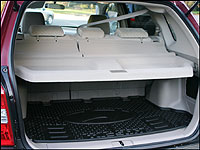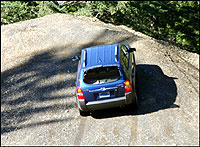2005 Hyundai Tucson V6 Road Test
11-6-2004
by
Trevor Hofmann
, Canadian Auto Press
|
Now that I'm talking about practicalities, I mentioned earlier that the Tucson doesn't deliver as much cargo room as the
 |
| The Tucson doesn't deliver as much cargo room as the longer Santa Fe, but much more than Toyota's RAV4. (Photo: Trevor Hofmann, Canadian Auto Press) |
longer Santa Fe. The elder Hyundai offers 864 L (30.5 cu ft) of volume with the split/folding rear seats in their upright positions, and 2,209 liters (78.0 cu ft) when the seatbacks are folded forward. In comparison the Tucson delivers a total of 644 liters of cargo capacity with the seatbacks upright, and 1,856 when laying flat. How does this compare with the RAV4 and CR-V? Well, the little Toyota is indeed little, with only 399 liters (14.1 cu ft) available for stowage when all seats are in use and 678 L (23.9 cu ft) when the back seats are dropped down. At the other end of the spectrum, the CR-V seems gargantuan, offering 949 liters (33.5 cu ft) for odds and ends when the seats are upright and 2,039 liters (72.0 cu ft) when lowered. Of course the CR-V feels more minivan-like than any of its peers, which no doubt is seen as a good thing by some and a negative by others. The Tucson sits in the middle, not as large, which makes it more maneuverable in traffic, and then again not too small, so that it can still live up to the utility part of its SUV image.
 |
| The Tucson offers optional all-wheel drive, but unlike most of its peers it's an extremely sophisticated Borg-Warner Electronic InterActive Torque Management system, enhancing traction. (Photo: Trevor Hofmann, Canadian Auto Press) |
Speaking about an SUV image, as previously mentioned the Tucson offers optional all-wheel drive, but unlike most of its peers it's a Borg-Warner Electronic InterActive Torque Management all-wheel drive system, previously only available in the top-line Santa Fe 3.5, saves fuel over traditional AWD by running up to 99 percent of the engine's power through the front wheels when traction is good. When road surfaces are slippery, the system automatically monitors throttle position, front wheel angle and slippage before sending up to 50 percent of the power to the rear wheels. What's more, a dash-mounted 4WD lock button allows the driver to manually lock the driveline into 50 percent front, 50 percent rear four-wheel drive for greater traction when needed. It only works at speeds under 40 km/h (25 mph), so when exceeding these speeds it disengages and reverts to regular AWD. Likewise, as soon as the SUV slows to the 40 km/h (25 mph) it automatically locks again, providing the manual lock button is still engaged. |
|
|

